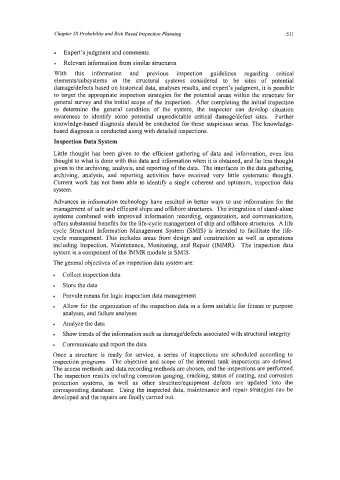Page 535 - Marine Structural Design
P. 535
Chapter 28 Probability and Risk Based Inspection Planning 51 1
Expert’s judgment and comments
Relevant information from similar structures
With this information and previous inspection guidelines regarding critical
elementdsubsystems in the structural systems considered to be sites of potential
damageldefects based on historical data, analyses results, and expert’s judgment, it is possible
to target the appropriate inspection strategies for the potential areas within the structure for
general survey and the initial scope of the inspection. After completing the initial inspection
to determine the general condition of the system, the inspector can develop situation
awareness to identify some potential unpredictable critical damage/defect sites. Further
knowledge-based diagnosis should be conducted for these suspicious areas. The knowledge-
based diagnosis is conducted along with detailed inspections.
Inspection Data System
Little thought has been given to the efficient gathering of data and information, even less
thought to what is done with this data and information when it is obtained, and far less thought
given to the archiving, analysis, and reporting of the data. The interfaces in the data gathering,
archiving, analysis, and reporting activities have received very little systematic thought.
Current work has not been able to identify a single coherent and optimum, inspection data
system.
Advances in information technology have resulted in better ways to use information for the
management of safe and efficient ships and offshore structures. The integration of stand-alone
systems combined with improved information recording, organization, and communication,
offers substantial benefits for the life-cycle management of ship and offshore structures. A life
cycle Structural Information Management System (SMIS) is intended to facilitate the life-
cycle management. This includes areas fkom design and construction as well as operations
including Inspection, Maintenance, Monitoring, and Repair (IMMR). The inspection data
system is a component of the IMMR module in SMIS.
The general objectives of an inspection data system are:
Collect inspection data
Store the data
Provide means for logic inspection data management
Allow for the organization of the inspection data in a form suitable for fitness or purpose
analyses, and failure analyses
Analyze the data
Show trends of the information such as damage/defects associated with structural integrity
Communicate and report the data
Once a structure is ready for service, a series of inspections are scheduled according to
inspection programs. The objective and scope of the internal tank inspections are defined.
The access methods and data recording methods are chosen, and the inspections are performed.
The inspection results including corrosion gauging, cracking, status of coating, and corrosion
protection systems, as well as other structure/equipment defects are updated into the
corresponding database. Using the inspected data, maintenance and repair strategies can be
developed and the repairs are finally carried out.

